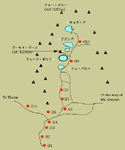|
はじめに
ヒマラヤの薬草は、古代インダス文明の時代から、その効能と希少性で珍重されていた。一例としてインドの古典文学「ラクシュマン・ブッティの薬草物語」を紹介しましょう。舞台は今から3千年程前、ヒマラヤの山麓にアヨダヤという王国がありました。国王ダサラットには三人の王妃がおり、王妃には各々に息子がいました。中でも第一夫人の息子ラムと第二夫人の息子ラクシュマンは仲が良く、実の兄弟のようでした。
年老いたダサラット王は、王位を最年長の息子ラムに譲ろうと考えていました。しかし第三夫人は自分の息子を王位に即けようと、王にラムを森で修行させるよう提言し、王はラムに14年間の森での生活を命じたのでした。ラムは、妻のシータと親友で異母兄弟のラクシュマンと共に森で暮らすことになりました。
ある日、ランカ(現スリランカ)の王が森でシータを見かけ、その美しさに心奪われ、シータを森から連れ去りました。妻を奪われたラムは怒り狂い、ランカに軍隊を差し向けました。その頃親友のラクシュマンは難病に倒れ、死に直面しており、ラムは助ける方法を模索していました。このことを聞きつけたラムを崇拝するハヌマーン神は、ヒマラヤのスメル・パルバット山に薬草を探しに向かいました。薬草は森の中で光を放っていたが、ハヌマーン神は気が付かず、何日かけても見つけられず、業をにやしてスメル・パルバット山を山ごと運び出しました。森の伝統医バイディア・ラーズは、山の中から薬草を探し出し、ラクシュマンを治療し、病の床から救いました。ラムは妻のシータを取り戻し、14年間の森の生活を終え、元気になったラクシュマンと共にアヨダヤ王に戻りました。そしてめでたく王位を継承したのでした。
この話はインドの「ラマヤン」という書物に出てくるのですが、昔からヒマラヤには多くの薬草があると信じられてきました。では21世紀を目前にした現代のヒマラヤはどうなのでしょうか。光を放つ秘薬は見つかるのか、その効能は確かなものなのか栽培は可能なのか報告します。
●購読希望の方は
美と健康を科学するフレグランスジャーナル社FRAGRANCE JOURNAL LTD.から発刊されているアロマの機能性(生理・心理的作用)と効用の学際的専門誌・季刊(2,5,8,11月) 「AROMA RESEARCH 第3号」に収載されています。
http://www.fragrance-j.co.jp/books/info/aroma/aro-research2.html
Abstract
The composition of the diverse floristic region of the Nepal Himalayas has contributed towards the uniquely rich vagetation, comprised of various forest types, in different bioclimatic zones, as described in the previous section, and varied landscape of both aesthetic and academic value. The varied physiolography has created ecozones in the Nepal Himalayan Region which, although small in area, is an unparalleled repository of biological diversity with inherent ecological features that are reflected by the occurence of various annual and perennial herbs in addition to different shrubs and trees of medicinal value. These plants are important components of the vegetation and are useful to the local communities also. The natural vegetation cover, whether woodlands, hills or slopes, valleys, river beds, or high Himalayan pastures, is the main source of medicinal herbs in the country. The vegetation of Nepal exhibits a remarkable plant diversity. Within a few sq. km area ( 147,181 sq. km, about 150-200 km in breadth and about 800-830 km in length ) some 6500 species of flowering plants, among which 700 species have been recognized as medicinal and aromatic plants are known to occur.
We have been traveled different parts of Himalayas during different time and seasons. In Gokyo 65 species of wild aromatic plants have been reported in "Medicinal Edible Plants used in the Himalayas and their Cultures" bulletin No.184, published by FFI Journal in 2000. This paper will focus on some new medicinal and aromatic plants beside 65 species of wild aromatic plants, also more about a cultural relationship between the himalayan people and utilization of natural resources in Namche area from Lukla to Gokyo (from 2,840m - 5,000m altitude) area of Sagarmatha National Park during last summer in 1999.
Key words : aromatic, medicinal, natural resources, himalaya
Survey of Wildflowers in the Nepal Himalayas (1)
Exploration of Himalayan Medicinal Herbs in Gokyo on Everest Road
Takashi Watanabe 1) and Kuber Jung Malla 2)
Medicinal Plant Garden, School of Pharmaceutical Sciences, Kitasato University 1)
Royal Botanical Garden, Department of Plant Resources, Godawari, Lalitpur, Nepal (Scientific Officer) 2)
|
) |



リンドウ科センブリの仲間 スウェルティア・ムルティカウリス

シソ科のフロミス・ロタータ(Phromis rotata)
|